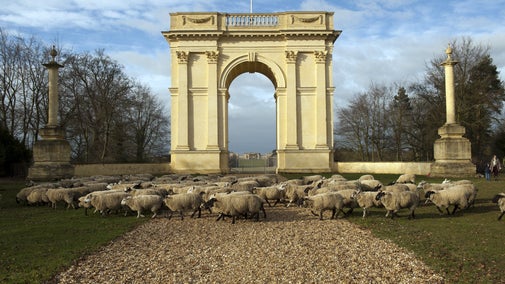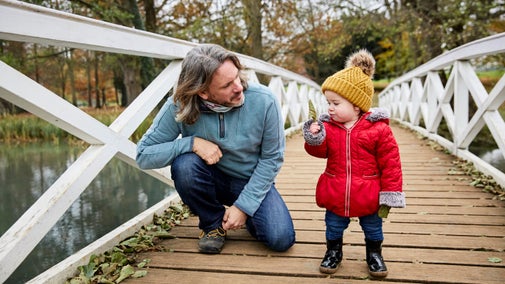
Donate
Everyone needs nature, now more than ever. Donate today and you could help people and nature to thrive at the places we care for.

Subtle gardening and major works have all helped to make the restoration of the gardens at Stowe appear as though they were always the way you see them today. Discover more about the conservation work carried out since the National Trust was gifted Stowe in 1989 and explore our plans for future projects that will help us create a place where everyone can enjoy nature, beauty and culture in a way that suits them.
Phase one involved the major restoration of the gardens and parkland. Some of the largest temples and monuments were at risk of falling down or were hidden amongst a jungle of trees and shrubs that had taken hold over the years.
When we opened the doors for the first time to public visitors, entry was via a little ticket shed by the front gates of Oxford Avenue, which led you up past the parkland and Stowe House, entering the gardens near to Concord and Victory.
In 2003 phase two of restoring Stowe started with the acquisition and restoration of New Inn. In the 1700s, when Stowe was a visitor attraction, tourists drove up Stowe Avenue to the Corinthian Arch and stayed at the New Inn. This entrance was designed to give subtle glimpses of the magnificent temples and house before you walked through and were left with breathtaking views.
2015 saw the start of this phase, comprising 54 tasks taking place over the coming years to return the gardens to their former 18th-century glory as created by Lord Cobham. Highlights included the return of missing statues, monuments, paths and the opening of parts of the gardens not previously open to the public.

Built in 1717, the New Inn was a coaching inn that provided rest and refreshment for Stowe’s first tourists. It was the original entry point used by the earliest visitors nearly 300 years ago when they came to marvel at the scale and splendour of the famous gardens.
After falling into decline it went into private ownership and spent many years as a farm. In 2005 the National Trust were able to purchase the New Inn. The restoration work was part of a £9 million project to transform the way that people visit and enjoy Stowe and it reopened to the public in 2012. Outside New Inn, the nostalgic atmosphere is further enhanced by the recreation of an 18th-century farmhouse kitchen garden, which provides crops and produce for use in the café.
In the 1760s, Earl Temple relocated a small open-sided temple called a fane to the Grecian Valley and rededicated it to pastoral poetry. A statue of Thalia, the Muse of Pastoral Poetry, was placed near the temple to act as the guardian spirit of the valley. As the original statue hadn’t survived, a replica was commissioned based on the statue of Heroic Poetry. The statue of Pastoral Poetry was finally returned to its original setting at the end of the Grecian Valley in December 2018.
Throughout 2019 and 2020, a project took place to restore and replace the statues of the Nine Muses, which had been at Stowe for around 100 years during the 18th century. Archaeology, historical maps, and documents were used to chart the statues' various locations around the gardens, as they had been moved on several occasions.
The arrival of Apollo in 2023 completed the group of ten statues located around Stowe’s Doric Arch, which stands at the entrance to the area known as Elysian Fields.
The Chinese House is a tiny folly, intricately decorated with Chinese scenes, flowers and calligraphy. Dating from around 1738 and believed to be designed by the architect William Kent (1685-1748), the Chinese House returned to Stowe in 1998 following a long stint in other locations.
Despite being protected in the winter, the paintwork had badly deteriorated and specialist conservators stabilised the paint layers to protect it for the future. Treatment to the exterior included consolidation of flaking paint layers, surface dirt removal, reforming of the existing varnish, gap filling, in-painting losses to the decorative scheme and applying a final varnish layer.

The new parkland trail at Stowe will offer a 3 ½ mile safe off-road path through beautiful parkland. The trail will follow existing paths, permissive routes and bridleways and completes a circular loop well away from the public highway. The trail will offer a family-friendly route suitable for walkers, pushchairs, adapted wheelchairs, cyclists and runners – giving visitors the opportunity to explore the wider parkland.
The tower will be a thriving ecosystem where wildlife and people can happily co-exist with net-positive impact on the environment. A place where we can share tales of the landscape and where visitors can gain a greater understanding of our place in nature. Bourbon Tower sits on the proposed route of the Stowe Parkland Trail. Once restored, it will offer first time public access to this extraordinary building.
The pavilion will be an accessible destination at the most Westerly point of the gardens. The two bedroom accommodation created in the 1950s will be removed and the structure glazed to provide shelter and security from the elements whilst also restoring the views. A mezzanine will be created to offer visitors a closer look at the cavernous roof structure and for use as an artist in residence studio space. The ground floor will offer exhibition space. The venue will also be hired out for meetings, workshops, intimate dinners and small events.
The iconic, 18th century Grade 1 listed carriage bridge at Stowe is in poor condition. It features in Historic England’s heritage ‘at risk’ register. Minimal conservation work has undertaken on the bridge in the thirty four years it’s been in the care of the National Trust.
In addition to heritage conservation and a restored setting, the project will deliver Improved access – via upgraded level access pathways and benches as well as creating new habitats, while existing habitats will be protected and improved.

Everyone needs nature, now more than ever. Donate today and you could help people and nature to thrive at the places we care for.
Unravel layers of history with a broad look at Stowe throughout the centuries, as well as the people who made it into the grand Georgian estate you can see today.

Discover how five people shaped the layout, design and structures we still enjoy today. Over less than 30 years this world-renowned garden took shape during their tenure.

Find out how the buildings, monuments and statues located throughout the garden and parkland at Stowe contain much significance in their positioning and the stories they tell.

Take the kids on an outdoor adventure this season as you explore a world of lakes, magical woods, enormous temples, colourful reflections and twisted trees.

We believe that nature, beauty and history are for everyone. That’s why we’re supporting wildlife, protecting historic sites and more. Find out about our work.

Find out more about the funding the National Trust receives from grants, and the projects it has helped support.
